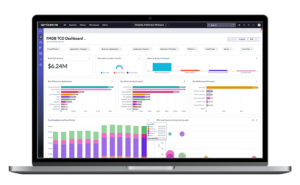According to the Flexera 2023 State of the Cloud Report, we’ve reached the tipping point where the majority of workloads are now in the public cloud. As cloud adoption continues to grow, more companies are turning to FinOps and cloud financial management as a way to rein in cloud costs.
Looking at the core practices of FinOps, however, there’s clear overlap with practices like IT financial management (ITFM), raising the question of where FinOps fits in and whether companies need both.
Below we look at where ITFM and FinOps intersect, where they diverge and the types of companies that should consider pursuing each.
Watch a short video on how Nicus helps companies manage cloud costs and improve cost transparency
ITFM and FinOps: A Shared Focus
ITFM and technology business management (TBM) are terms used to describe practices that provide visibility into IT spend as a whole, while FinOps is aimed at managing cloud costs.
ITFM and FinOps share a similar focus in terms of cost optimization, financial transparency and accountability, and linking technology investments with business goals. The core principles of FinOps apply to ITFM and TBM as well, with the exception of the sixth principle of leveraging the cloud’s variable cost model.
Many of the capabilities and domains outlined by the FinOps Foundation practice are also found in ITFM, including:
- Cost allocation and managing shared costs
- Showback and chargeback
- Forecasting and budget management
- Measuring unit costs as a way to assess value of spending
Key Differences and Complementary Capabilities
Despite their similarities, where ITFM and FinOps diverge is the lens through which they operate:
- ITFM looks at costs across the organization’s entire IT footprint, rather than just cloud spending
- ITFM takes a top-down approach typically driven by the CIO and senior leadership, whereas FinOps is driven from the bottom-up by cloud practitioners making real-time decisions about cloud optimization
With ITFM, organizations get the macro view into the total cost of ownership (TCO) to support IT decision-making on monthly reporting cycles. In turn, FinOps provides granular detail on cloud usage and costs to give cloud practitioners immediate control over cloud consumption and day-to-day tradeoff decisions.
In analyst firm Gartner’s recent Market Guide for IT Financial Management Tools, they predict that “most FinOps adopters will need additional ITFM capabilities to manage the total cost of cloud, which will feed interest in a total cost of IT solution.”
FinOps Gray Areas
Despite the growing prevalence of FinOps, several gray areas exist in terms of costs that FinOps does not capture, such as:
- Internal labor costs
- Software and SaaS application costs
- Cloud management tools and managed services
- Security and infrastructure
- Facilities and networking
- Telecommunications
These costs, if not managed closely, can easily spiral out of control, especially considering that some of these costs may even increase when moving to the cloud.
As Gartner notes, many organizations underestimate what’s required to manage cloud costs, forcing infrastructure and operations (I&O) teams to firefight costs rather than proactively optimize them. There’s also pressure for these teams to hit migration targets first and optimize later—only to be faced with an avalanche of unexpected cloud costs and tech debt.
ITFM + FinOps: A Synergistic Effect
The dynamic nature of cloud costs and consumption makes FinOps a necessity for companies with a significant portion of their technology estate on public clouds. For large organizations with a complex IT landscape, ITFM is also essential for the full context of cloud spending, including TCO and where to prioritize investments.
As such, most experts agree that ITFM and FinOps are complementary disciplines that lead to more effective decision-making when used together.
Each one feeds data to the other, providing more accurate unit costs that reveal the true business value of spending. By setting specific efficiency standards about where to invest resources, companies can thus reduce tech debt by releasing development teams from working on solutions that don’t drive enough value.
ITFM and FinOps share several commonalities, but they both offer distinct perspectives on how to manage technology spend. Where ITFM provides a holistic view of IT costs consumed from all parts of the business, FinOps excels in real-time cloud cost optimization. Combining the two is vital to maximizing IT business value, especially for large organizations with diverse IT landscapes.
Read ITFM vs. FinOps Part 2: How FinOps and IT Financial Management Work Together







